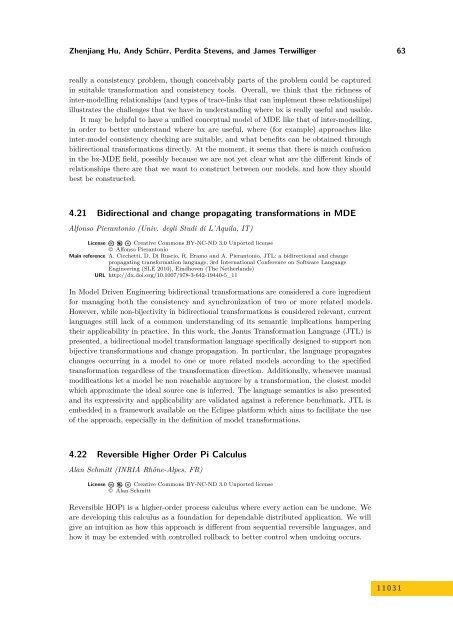Volume 1, Issue 1, January 2011 - DROPS - Schloss Dagstuhl
Volume 1, Issue 1, January 2011 - DROPS - Schloss Dagstuhl
Volume 1, Issue 1, January 2011 - DROPS - Schloss Dagstuhl
Create successful ePaper yourself
Turn your PDF publications into a flip-book with our unique Google optimized e-Paper software.
Zhenjiang Hu, Andy Schürr, Perdita Stevens, and James Terwilliger 63<br />
really a consistency problem, though conceivably parts of the problem could be captured<br />
in suitable transformation and consistency tools. Overall, we think that the richness of<br />
inter-modelling relationships (and types of trace-links that can implement these relationships)<br />
illustrates the challenges that we have in understanding where bx is really useful and usable.<br />
It may be helpful to have a unified conceptual model of MDE like that of inter-modelling,<br />
in order to better understand where bx are useful, where (for example) approaches like<br />
inter-model consistency checking are suitable, and what benefits can be obtained through<br />
bidirectional transformations directly. At the moment, it seems that there is much confusion<br />
in the bx-MDE field, possibly because we are not yet clear what are the different kinds of<br />
relationships there are that we want to construct between our models, and how they should<br />
best be constructed.<br />
4.21 Bidirectional and change propagating transformations in MDE<br />
Alfonso Pierantonio (Univ. degli Studi di L’Aquila, IT)<br />
License Creative Commons BY-NC-ND 3.0 Unported license<br />
© Alfonso Pierantonio<br />
Main reference A. Cicchetti, D. Di Ruscio, R. Eramo and A. Pierantonio, JTL: a bidirectional and change<br />
propagating transformation language, 3rd International Conference on Software Language<br />
Engineering (SLE 2010), Eindhoven (The Netherlands)<br />
URL http://dx.doi.org/10.1007/978-3-642-19440-5_11<br />
In Model Driven Engineering bidirectional transformations are considered a core ingredient<br />
for managing both the consistency and synchronization of two or more related models.<br />
However, while non-bijectivity in bidirectional transformations is considered relevant, current<br />
languages still lack of a common understanding of its semantic implications hampering<br />
their applicability in practice. In this work, the Janus Transformation Language (JTL) is<br />
presented, a bidirectional model transformation language specifically designed to support non<br />
bijective transformations and change propagation. In particular, the language propagates<br />
changes occurring in a model to one or more related models according to the specified<br />
transformation regardless of the transformation direction. Additionally, whenever manual<br />
modifications let a model be non reachable anymore by a transformation, the closest model<br />
which approximate the ideal source one is inferred. The language semantics is also presented<br />
and its expressivity and applicability are validated against a reference benchmark. JTL is<br />
embedded in a framework available on the Eclipse platform which aims to facilitate the use<br />
of the approach, especially in the definition of model transformations.<br />
4.22 Reversible Higher Order Pi Calculus<br />
Alan Schmitt (INRIA Rhône-Alpes, FR)<br />
License Creative Commons BY-NC-ND 3.0 Unported license<br />
© Alan Schmitt<br />
Reversible HOPi is a higher-order process calculus where every action can be undone. We<br />
are developing this calculus as a foundation for dependable distributed application. We will<br />
give an intuition as how this approach is different from sequential reversible languages, and<br />
how it may be extended with controlled rollback to better control when undoing occurs.<br />
1 1 0 3 1













